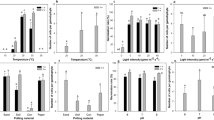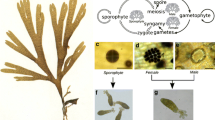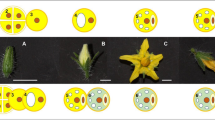Abstract
Spores (collected at 10 ± 1 °C, 2 h after releasing) and young gametophytes (newly generated from spores cultured at 10 ± 1 °C for 8 days) of Saccharina japonica were first cultured at 15 ± 1, 19 ± 1, and 23 ± 1 °C for various times (2, 5, and 8 days) and then at 10 ± 1 °C (culturing patterns S and G, respectively). Spores were also cultured at a constant of 10 ± 1 °C (pattern C) and used as the control. The length and percentage of young gametophytes, size and percentage of gametophytes, and ratio of female to male gametophytes were measured in order to determine the effect of temperature on the development of gametophytes. Temperature and exposure time of spores and young gametophytes at the first culturing temperature significantly affected the development of gametophytes as were indicated by all biological parameters except the ratio of female to male gametophytes. The spores were more sensitive to temperature than young gametophytes. Gametophytes developed from the spores that survived temperature stress can recover their growth. High temperature selection at the early developmental stages of gametophytes was effective for screening gametophytes applicable for breeding high temperature-resistant varieties and hybrids.





Similar content being viewed by others
References
Bajaj M, Cresti M, Shivanna KR (1992) Effects of high temperature and humidity stresses on tobacco pollen and their progeny. In: Ottaviano E, Mulcahy DL, Sari Gorla M, Mulcahy GB (eds) Angiosperm pollen and ovules. Springer, New York, pp 349–354
Bartsch I, Wiencke C, Bischof K, Buchholz CM, Buck BH, Eggert A, Feuerpfeil P, Hanelt D, Jacobsen S, Karez R (2008) The genus Laminaria sensu lato: recent insights and developments. Eur J Phycol 43:1–86
Chang Y-K, Blischak L, Veilleux R, Iqbal M (2010) Effect of temperature on gametophytic selection in a Phalaenopsis F1 population. Euphytica 171:251–261
Clarke HJ, Khan TN, Siddique KHM (2004) Pollen selection for chilling tolerance at hybridisation leads to improved chickpea cultivars. Euphytica 139:65–74
Coelho SM, Rijstenbil JW, Brown MT (2000) Impacts of anthropogenic stresses on the early development stages of seaweeds. J Aquat Ecosys Stress Recovery 7:317–333
Darakov OB (1995) Gametophyte selection of tomatoes for resistance to early blight disease. Sex Plant Reprod 8:95–98
Davison IR (1987) Adaptation of photosynthesis in Laminaria saccharina (Phaeophyta) to changes in growth temperature. J Phycol 23:273–283
Davison IR, Greene R, Podolak E (1991) Temperature acclimation of respiration and photosynthesis in the brown alga Laminaria saccharina. Mar Biol 110:449–454
Domínguez E, Cuartero J, Fernández-Muñoz R (2005) Breeding tomato for pollen tolerance to low temperatures by gametophytic selection. Euphytica 142:253–263
Fang TC, Wu CY, Jiang BY, Li JJ, Ren GZ (1962) The breeding of a new variety of HAIDAI (Laminaria japonica Aresch.) and its preliminary genetic analysis. J Integr Plant Biol 10:197–209, in Chinese with English abstract
Fang ZX, Ou YL, Cui JJ, Dai JX (1978) Success in culturing clones of the gametophytes of Laminaria japonica. Chin Sci Bull 23:115–116, in Chinese with English abstract
Frova C, Portaluppi P, Villa M, Goria MS (1995) Sporophytic and gametophytic components of thermotolerance affected by pollen selection. J Hered 86:50–54
Funano T (1983) The ecology of Laminaria religiosa Miyabe, 1: the life history and the alternation of nuclear phases of Laminaria religiosa, and the physiological ecology of the gametophytes and the embryonal sporophytes. Sci Rep Hokkaido Fish Exp Station 25:61–109
Gerard VA (1997) The role of nitrogen nutrition in high temperature tolerance of the kelp Laminaria saccharina (Chromophyta). J Phycol 33:800–810
Henry EC, Cole KM (1982) Ultrastructure of swarmers in the Laminariales (Phaeophyceae). I. Zoospores. J Phycol 18:550–569
Hormaza JI, Herrero M (1996) Male gametophytic selection as a plant breeding tool. Sci Hortic 65:321–333
Izquierdo J, Pérez-Ruzafa I, Gallardo T (2002) Effect of temperature and photon fluence rate on gametophytes and young sporophytes of Laminaria ochroleuca Pylaie. Helgoland Mar Res 55:285–292
Koval VS (2000) Male and female gametophyte selection of barley for salt tolerance. Hereditas 132:1–5
Lee J, Brinkhuis BH (1988) Seasonal light and temperature interaction effects on development of Laminaria saccharina (Phaeophyta) gametophytes and juvenile sporophytes. J Phycol 24:181–191
Li H (1990) Notes on the Laminaria raft cultivation method. Mariculture 1990(1/2):41–48
Li X (2008) Breeding and application of hybrid Laminaria. Dissertation, Ocean University of China (in Chinese with English abstract)
Li D, Zhou Z, Liu H, Wu C (1999) A new method of Laminaria japonica strain selection and sporeling raising by the use of gametophyte clones. Hydrobiologia 398:473–476
Li X, Wang G, Zhang Q, Zhang Z, Luo S (2004) Effect of temperature on growth of gametophyte clones of variety “901” of Laminaria japonica. Fisheries Sci Technol Inform 31:166–168 (in Chinese)
Li X, Cong Y, Yang G, Shi Y, Qu S, Li Z, Wang G, Zhang Z, Luo S, Dai H, Xie J, Jiang G, Liu J, Wang T (2007) Trait evaluation and trial cultivation of Dongfang no. 2, the hybrid of a male gametophyte clone of Laminaria longissima (Laminariales, Phaeophyta) and a female one of L. japonica. J Appl Phycol 19:139–151
Li X, Liu J, Cong Y, Qu S, Zhang Z, Dai H, Luo S, Han X, Huang S, Wang Q, Liang G, Sun J, Jin Y, Wang D, Yang G (2008) Breeding and trial cultivation of Dongfang no. 3, a hybrid of Laminaria gametophyte clones with a more than intraspecific but less than interspecific relationship. Aquaculture 280:76–80
Machalek K, Davison I, Falkowski P (1996) Thermal acclimation and photoacclimation of photosynthesis in the brown alga Laminaria saccharina. Plant Cell Environ 19:1005–1016
Mulcahy DL (1979) The rise of the angiosperms: a genecological factor. Science 206:20–23
Oliveira L, Walker D, Bisalputra T (1980) Ultrastructural, cytochemical, and enzymatic studies on the adhesive “plaques” of the brown algae Laminaria saccharina (L.) Lamour. and Nereocystis luetkeana (Mert.) Post. et Rrupr.1. Protoplasma 104:1–15
Robert T, Lamy F, Sarr A (1992) Evolutionary role of gametophytic selection in the domestication of Pennisetum thyphoides (pearl millet): a two-locus asymmetrical model. Heredity 69:372–381
Roleda MY, Wiencke C, Hanelt D, Van De Poll WH, Gruber A (2005) Sensitivity of Laminariales zoospores from Helgoland (North Sea) to ultraviolet and photosynthetically active radiation: implications for depth distribution and seasonal reproduction. Plant Cell Environ 28:466–479
Seoighe C, Gehring C, Hurst LD (2005) Gametophytic selection in Arabidopsis thaliana supports the selective model of intron length reduction. PLoS Genet 1(2):0154–0158
Sokal RR, Rohlf FJ (1995) Biometry, 3rd edn. W.H. Freeman, New York, p 807
Steinhoff F, Wiencke C, Müller R, Bischof K (2008) Effects of ultraviolet radiation and temperature on the ultrastructure of zoospores of the brown macroalga Laminaria hyperborea. Plant Biol 10:388–397
Tala F, Véliz K, Gómez I, Edding M (2007) Early life stages of the South Pacific kelps Lessonia nigrescens and Lessonia trabeculata (Laminariales, Phaeophyceae) show recovery capacity following exposure to UV radiation. Phycologia 46:467–470
Tseng CK (2001) Algal biotechnology industries and research activities in China. J Appl Phycol 13:375–380
Tseng CK, Sun KY, Wu CY (1955) On the cultivation of Haidai (Laminaria japonica Aresch) by summering young sporophytes at low temperature. Acta Bot Sinica 4(3):255–264 (in Chinese with English abstract)
Véliz K, Edding M, Tala F, Gómez I (2006) Effects of ultraviolet radiation on different life cycle stages of the south Pacific kelps Lessonia nigrescens and Lessonia trabeculata (Laminariales, Phaeophyceae). Mar Biol 149:1015–1024
Voskoboinikov GM, Kamnev AN (1991) Morphofunctional changes of the chloroplasts during the seaweed ontogenesis. Nauka, Leningrad, p 96
Wang ML (1987) Adaptability of female Laminaria clone to high temperatures for several different species. J Shandong College Oceanol 17(2):72–76 (in Chinese with English abstract)
Wang Y (2003) The physiological and biochemical responses to heat stress and the preliminary study on heat-resistant mechanisms in Laminaria japonica. Dissertation, Ocean University of China (in Chinese with English abstract)
Zamir D, Gadish I (1987) Pollen selection for low temperature adaptation in tomato. Theor Appl Genet 74:545–548
Zamir D, Tanksley SD, Jones RA (1982) Haploid selection for low temperature tolerance of tomato pollen. Genetics 101:129–137
Zhang QS, Tang XX, Cong YZ, Qu SC, Luo SJ, Yang GP (2007) Breeding of an elite Laminaria variety 90-1 through inter-specific gametophyte crossing. J Appl Phycol 19:303–311
Acknowledgments
This study was financially supported by National High Technology Research and Development Program of China (863 Program) (grant no. 2012AA10A406).
Author information
Authors and Affiliations
Corresponding author
Rights and permissions
About this article
Cite this article
Zhang, L., Cui, C., Li, X. et al. Effect of temperature on the development of Saccharina japonica gametophytes. J Appl Phycol 25, 261–267 (2013). https://doi.org/10.1007/s10811-012-9860-y
Received:
Revised:
Accepted:
Published:
Issue Date:
DOI: https://doi.org/10.1007/s10811-012-9860-y




